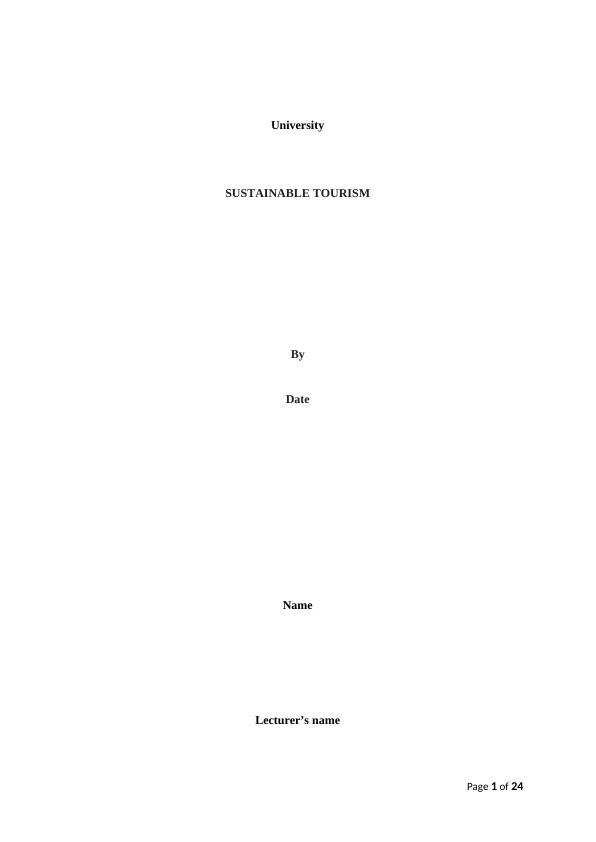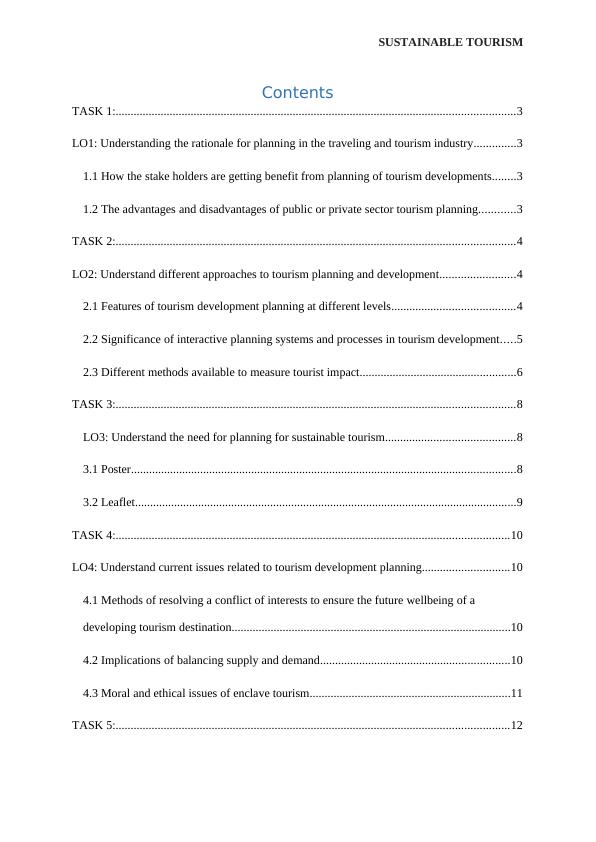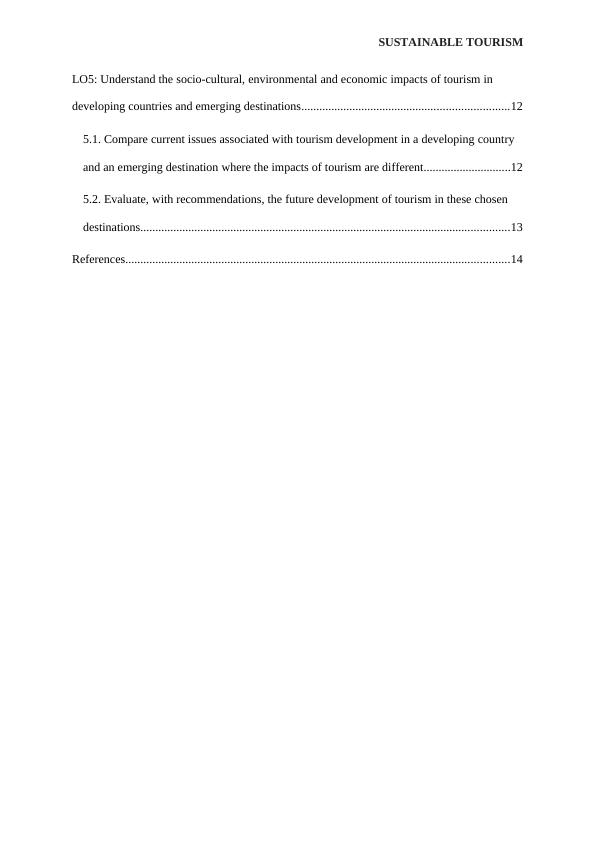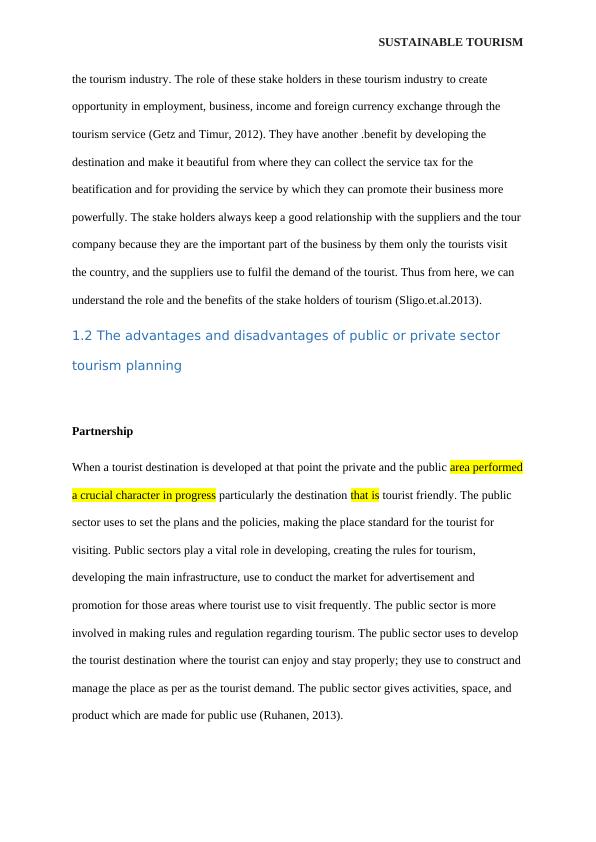Sustainable Tourism: Planning, Stakeholders, and Impacts
Added on 2023-04-10
24 Pages4725 Words293 Views
University
SUSTAINABLE TOURISM
By
Date
Name
Lecturer’s name
Page 1 of 24
SUSTAINABLE TOURISM
By
Date
Name
Lecturer’s name
Page 1 of 24

SUSTAINABLE TOURISM
Contents
TASK 1:.....................................................................................................................................3
LO1: Understanding the rationale for planning in the traveling and tourism industry..............3
1.1 How the stake holders are getting benefit from planning of tourism developments........3
1.2 The advantages and disadvantages of public or private sector tourism planning............3
TASK 2:.....................................................................................................................................4
LO2: Understand different approaches to tourism planning and development.........................4
2.1 Features of tourism development planning at different levels.........................................4
2.2 Significance of interactive planning systems and processes in tourism development.....5
2.3 Different methods available to measure tourist impact....................................................6
TASK 3:.....................................................................................................................................8
LO3: Understand the need for planning for sustainable tourism...........................................8
3.1 Poster................................................................................................................................8
3.2 Leaflet...............................................................................................................................9
TASK 4:...................................................................................................................................10
LO4: Understand current issues related to tourism development planning.............................10
4.1 Methods of resolving a conflict of interests to ensure the future wellbeing of a
developing tourism destination.............................................................................................10
4.2 Implications of balancing supply and demand...............................................................10
4.3 Moral and ethical issues of enclave tourism...................................................................11
TASK 5:...................................................................................................................................12
Contents
TASK 1:.....................................................................................................................................3
LO1: Understanding the rationale for planning in the traveling and tourism industry..............3
1.1 How the stake holders are getting benefit from planning of tourism developments........3
1.2 The advantages and disadvantages of public or private sector tourism planning............3
TASK 2:.....................................................................................................................................4
LO2: Understand different approaches to tourism planning and development.........................4
2.1 Features of tourism development planning at different levels.........................................4
2.2 Significance of interactive planning systems and processes in tourism development.....5
2.3 Different methods available to measure tourist impact....................................................6
TASK 3:.....................................................................................................................................8
LO3: Understand the need for planning for sustainable tourism...........................................8
3.1 Poster................................................................................................................................8
3.2 Leaflet...............................................................................................................................9
TASK 4:...................................................................................................................................10
LO4: Understand current issues related to tourism development planning.............................10
4.1 Methods of resolving a conflict of interests to ensure the future wellbeing of a
developing tourism destination.............................................................................................10
4.2 Implications of balancing supply and demand...............................................................10
4.3 Moral and ethical issues of enclave tourism...................................................................11
TASK 5:...................................................................................................................................12

SUSTAINABLE TOURISM
LO5: Understand the socio-cultural, environmental and economic impacts of tourism in
developing countries and emerging destinations.....................................................................12
5.1. Compare current issues associated with tourism development in a developing country
and an emerging destination where the impacts of tourism are different.............................12
5.2. Evaluate, with recommendations, the future development of tourism in these chosen
destinations...........................................................................................................................13
References................................................................................................................................14
LO5: Understand the socio-cultural, environmental and economic impacts of tourism in
developing countries and emerging destinations.....................................................................12
5.1. Compare current issues associated with tourism development in a developing country
and an emerging destination where the impacts of tourism are different.............................12
5.2. Evaluate, with recommendations, the future development of tourism in these chosen
destinations...........................................................................................................................13
References................................................................................................................................14

SUSTAINABLE TOURISM
TASK 1:
LO1: Understanding the rationale for planning in the
traveling and tourism industry
1.1 How the stake holders are getting benefit from planning of
tourism developments
Philippines is a country where tourism is the most popular business in the country, and it is
one of the huge economy boosters for the country. As the agriculture and another source of
business is not so strong but as per as the greenery and the historic places are active in the
country for that reason tourism is the proper business of that country. The climate or the
weather of the country is very much suitable for tourism. The country is full of greenery and
water, so the sustainable tourism is the best option. For these case and the reasons of
sustainable tourism, the government wants to preserve the culture, forest and the entire
ecosystem of the country because it has a huge impact on the Philippines economy (Ashton,
2014). The government, tourism department and some other business organization are the
stake holder of the tourism. During the time of planning for tourism that time the involvement
of the stake holder are required because as they are the part of the tourism department, they
also can give inputs to the plan regarding the proper business. The benefit of the stake holders
is gain profit and to promote the business among the people. Traveling and tourism is one of
the fast progressive industry across the world and Philippines is going well in this business.
In tourism destination stake holders refers to the host and the tourist. They also give
preference to the business sector, public sectors and non-profitable sectors for better business
in tourism and to develop the tourism. As Per as the world tour organization stake holders is
dived into three major sectors: local community or the government, environment support and
TASK 1:
LO1: Understanding the rationale for planning in the
traveling and tourism industry
1.1 How the stake holders are getting benefit from planning of
tourism developments
Philippines is a country where tourism is the most popular business in the country, and it is
one of the huge economy boosters for the country. As the agriculture and another source of
business is not so strong but as per as the greenery and the historic places are active in the
country for that reason tourism is the proper business of that country. The climate or the
weather of the country is very much suitable for tourism. The country is full of greenery and
water, so the sustainable tourism is the best option. For these case and the reasons of
sustainable tourism, the government wants to preserve the culture, forest and the entire
ecosystem of the country because it has a huge impact on the Philippines economy (Ashton,
2014). The government, tourism department and some other business organization are the
stake holder of the tourism. During the time of planning for tourism that time the involvement
of the stake holder are required because as they are the part of the tourism department, they
also can give inputs to the plan regarding the proper business. The benefit of the stake holders
is gain profit and to promote the business among the people. Traveling and tourism is one of
the fast progressive industry across the world and Philippines is going well in this business.
In tourism destination stake holders refers to the host and the tourist. They also give
preference to the business sector, public sectors and non-profitable sectors for better business
in tourism and to develop the tourism. As Per as the world tour organization stake holders is
dived into three major sectors: local community or the government, environment support and

SUSTAINABLE TOURISM
the tourism industry. The role of these stake holders in these tourism industry to create
opportunity in employment, business, income and foreign currency exchange through the
tourism service (Getz and Timur, 2012). They have another .benefit by developing the
destination and make it beautiful from where they can collect the service tax for the
beatification and for providing the service by which they can promote their business more
powerfully. The stake holders always keep a good relationship with the suppliers and the tour
company because they are the important part of the business by them only the tourists visit
the country, and the suppliers use to fulfil the demand of the tourist. Thus from here, we can
understand the role and the benefits of the stake holders of tourism (Sligo.et.al.2013).
1.2 The advantages and disadvantages of public or private sector
tourism planning
Partnership
When a tourist destination is developed at that point the private and the public area performed
a crucial character in progress particularly the destination that is tourist friendly. The public
sector uses to set the plans and the policies, making the place standard for the tourist for
visiting. Public sectors play a vital role in developing, creating the rules for tourism,
developing the main infrastructure, use to conduct the market for advertisement and
promotion for those areas where tourist use to visit frequently. The public sector is more
involved in making rules and regulation regarding tourism. The public sector uses to develop
the tourist destination where the tourist can enjoy and stay properly; they use to construct and
manage the place as per as the tourist demand. The public sector gives activities, space, and
product which are made for public use (Ruhanen, 2013).
the tourism industry. The role of these stake holders in these tourism industry to create
opportunity in employment, business, income and foreign currency exchange through the
tourism service (Getz and Timur, 2012). They have another .benefit by developing the
destination and make it beautiful from where they can collect the service tax for the
beatification and for providing the service by which they can promote their business more
powerfully. The stake holders always keep a good relationship with the suppliers and the tour
company because they are the important part of the business by them only the tourists visit
the country, and the suppliers use to fulfil the demand of the tourist. Thus from here, we can
understand the role and the benefits of the stake holders of tourism (Sligo.et.al.2013).
1.2 The advantages and disadvantages of public or private sector
tourism planning
Partnership
When a tourist destination is developed at that point the private and the public area performed
a crucial character in progress particularly the destination that is tourist friendly. The public
sector uses to set the plans and the policies, making the place standard for the tourist for
visiting. Public sectors play a vital role in developing, creating the rules for tourism,
developing the main infrastructure, use to conduct the market for advertisement and
promotion for those areas where tourist use to visit frequently. The public sector is more
involved in making rules and regulation regarding tourism. The public sector uses to develop
the tourist destination where the tourist can enjoy and stay properly; they use to construct and
manage the place as per as the tourist demand. The public sector gives activities, space, and
product which are made for public use (Ruhanen, 2013).

SUSTAINABLE TOURISM
As per as the private sector the private sector also has important roles to play regarding
tourism. They also take part in preparing for activities, product, and space but then also they
are more focused on profit-oriented business and development (Mowforth and Munt, 2015).
Here the product, activities, and space are very much different from the public sectors here
the product refers to the involvement, service, and hospitality, activity refers to group
activity, and event development and space refers to the development of suitable location
(Weaver and Jin, 2016). The private sectors always focused on developing and giving
accommodation in apartments and hotels, making cafes and restaurants fo0r the beverages
and food, for entertainment shopping malls, parks, cinema halls are being made by the private
sectors. The incentives are provided by the public sector for the .investments made by the
private sectors for developing the tourism destination. There is the good connection among
the stake holders on making the tourist friendly environment for tourism. The tourist will
have a great experience and will enjoy the tour for these tourism friendly concept. Both the
private sector and the public sector are interrelated which is helping to develop the tourism of
Philippines. Sometime the public sector act as the pioneer when the private sector is running
out of money rather it is a vice versa process for tourism which helps the country.
As per as the private sector the private sector also has important roles to play regarding
tourism. They also take part in preparing for activities, product, and space but then also they
are more focused on profit-oriented business and development (Mowforth and Munt, 2015).
Here the product, activities, and space are very much different from the public sectors here
the product refers to the involvement, service, and hospitality, activity refers to group
activity, and event development and space refers to the development of suitable location
(Weaver and Jin, 2016). The private sectors always focused on developing and giving
accommodation in apartments and hotels, making cafes and restaurants fo0r the beverages
and food, for entertainment shopping malls, parks, cinema halls are being made by the private
sectors. The incentives are provided by the public sector for the .investments made by the
private sectors for developing the tourism destination. There is the good connection among
the stake holders on making the tourist friendly environment for tourism. The tourist will
have a great experience and will enjoy the tour for these tourism friendly concept. Both the
private sector and the public sector are interrelated which is helping to develop the tourism of
Philippines. Sometime the public sector act as the pioneer when the private sector is running
out of money rather it is a vice versa process for tourism which helps the country.

End of preview
Want to access all the pages? Upload your documents or become a member.
Related Documents
Sustainable Tourism in Philippines - Reportlg...
|20
|3725
|169
Sustainable Tourism Developmentlg...
|19
|4858
|36
Report on Planning in Philippines Tourism Industrylg...
|13
|4124
|77
Sustainable Tourism Development INTRODUCTIONlg...
|13
|4307
|115
Sustainable Tourism Development : Case Studylg...
|17
|5759
|64
Sustainable Development in Philippine Tourismlg...
|19
|5828
|58